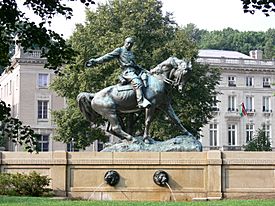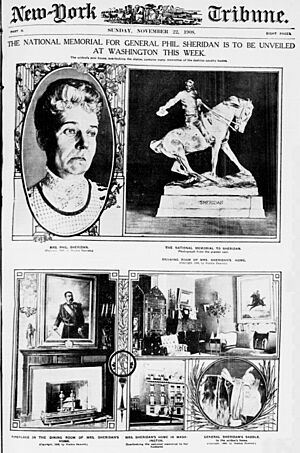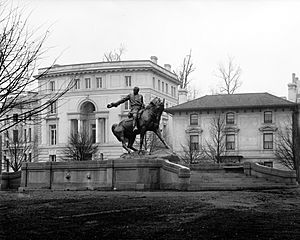Equestrian statue of Philip Sheridan facts for kids
 |
|
| Coordinates | 38°54′44″N 77°03′02″W / 38.912171°N 77.0506°W |
|---|---|
|
Equestrian statue of Philip Sheridan
|
|
|
U.S. Historic district
Contributing property |
|
| Part of | Civil War Monuments in Washington, D.C. |
| NRHP reference No. | 78000257 |
| Added to NRHP | September 20, 1978 |
| Location | Sheridan Circle, Washington, D.C., United States |
| Designer | Gutzon Borglum (sculptor) Henry Winslow (architect) |
| Material | Bronze (sculpture) Granite (base) |
| Length | 12 feet (3.7 m) |
| Width | 5 feet (1.5 m) |
| Height | 10 feet (3.0 m) |
| Opening date | November 25, 1908 |
| Dedicated to | Philip Sheridan |
The General Philip Sheridan monument is a large bronze sculpture in Washington, D.C.. It honors Philip Sheridan, a brave general who fought for the Union Army during the American Civil War. The famous sculptor Gutzon Borglum, who also designed Mount Rushmore, created this statue. It was officially shown to the public on November 25, 1908. Important people like President Theodore Roosevelt and many military leaders were there. This statue shows General Sheridan riding his horse. It stands in the middle of Sheridan Circle and is one of many Civil War monuments in the city. The National Park Service takes care of the statue and the park around it.
Contents
History of the Sheridan Monument
Who Was General Philip Sheridan?
Philip Sheridan was an important officer in the United States Army. He helped the Union Army win many battles during the Valley campaigns of 1864, especially the Battle of Cedar Creek. Many Union generals had statues built in their honor in Washington, D.C..
Sheridan once saw a statue of another general on a horse. He didn't like how the horse looked. He told his wife, Irene, "Whatever you do after I'm gone, don't put me on a horse like that." After he passed away in 1888, Irene made sure the horse in his statue would look "proud and courageous."
Choosing the Sculptor
In 1889, the U.S. Congress decided to build a memorial for Sheridan. They set aside $50,000 for it. The first artist chosen was John Quincy Adams Ward, a friend of Sheridan's. Ward had created other statues in Washington, D.C.
He signed a contract in 1892 to finish the statue by 1898. However, Ward was very slow. By 1903, he had only made a study of Sheridan's head. When Irene and her son, Philip Jr., finally saw Ward's model, they did not like it. It showed Sheridan as an older, heavy officer on a stiff-looking horse. Because of this, the government canceled Ward's contract in 1905.
Gutzon Borglum had been watching the problems with Ward's work. Borglum believed he could do a much better job. He studied Sheridan's life by reading his memoirs and biographies. Borglum met Irene Sheridan at a party and invited her to his studio. He impressed her with how much he knew about her husband. On July 2, 1907, Borglum was given the contract to sculpt the memorial.
Borglum was a Danish American artist. He is most famous for carving the faces on Mount Rushmore. The Sheridan sculpture is his only statue of a person on a horse in Washington, D.C.
Designing the Statue
On January 17, 1908, Borglum's design was approved. Irene Sheridan also loved the design. She chose the spot for the memorial, which was close to her home on Massachusetts Avenue.
As Borglum worked, he talked to Sheridan's friends and sketched his belongings. He also visited Irene often. Since Philip Jr. looked a lot like his father, Borglum used him as a model. When the statue was finished, Irene, Philip Jr., and Sheridan's three daughters were very happy with it.
The statue shows Sheridan riding his horse, Rienzi. It captures a moment from the Battle of Cedar Creek in 1864. Sheridan had ridden 20 miles (32 km) to reach the battle. After the Union won, Sheridan renamed his horse Winchester. After Winchester died in 1878, Sheridan had him preserved. The horse is now on display at the National Museum of American History.
The U.S. Congress paid for the plaza and the base of the monument. Veterans from the Army of the Cumberland paid for the statue itself. Henry Winslow designed the base.
Unveiling the Monument
The Sheridan memorial was officially shown to the public on November 25, 1908. A large crowd gathered for the event. Many important people were there, including President Theodore Roosevelt, military officers, and veterans from the Civil War.
A parade of troops marched past the crowd, and the United States Marine Band played music. Secretary of War Luke E. Wright led the ceremony. President Roosevelt gave a short speech praising Sheridan's brave actions. After Irene and Philip Jr. removed the cover from the statue, the crowd cheered loudly. Many people began to recite a famous poem about Sheridan called Sheridan's Ride.
Historic Recognition
The General Philip Sheridan monument was added to the National Register of Historic Places (NRHP) on September 20, 1978. The NRHP is a list of places important to American history. It was also added to the District of Columbia Inventory of Historic Sites in 1979. The statue and the park around it are cared for by the National Park Service.
Design and Location
This bronze statue of General Sheridan on his horse is in the center of Sheridan Circle. This is a traffic circle where 23rd Street, R Street, and Massachusetts Avenue NW meet. The statue is 10 feet (3.0 m) tall and 12 feet (3.7 m) long. The rectangular granite base is 3 feet (0.91 m) high.
The horse is slightly reared up on a rocky surface. Sheridan is turned to his right, with his right arm reaching behind him. He is holding his hat in his right hand and the horse's reins in his left. Sheridan is wearing a military uniform with a long coat. He is shown with a mustache and wavy hair.
The statue is surrounded by a plaza that is 37 feet (11 m) long. There are five steps leading up to the sculpture from the front and back. Curved benches are inside the plaza, facing the statue. The outside of the plaza has two pairs of lion head fountain spouts. Water used to pour from these spouts into square basins, but this feature no longer works.
The monument has these words carved into it:
- GUTZON BORGLUM 1908 (on the left side of the sculpture)
- GORHAM CO FOUNDERS (on the right side of the sculpture near the base)
- SHERIDAN (on the front side of the base)
See also
 In Spanish: Estatua ecuestre de Philip Sheridan para niños
In Spanish: Estatua ecuestre de Philip Sheridan para niños




